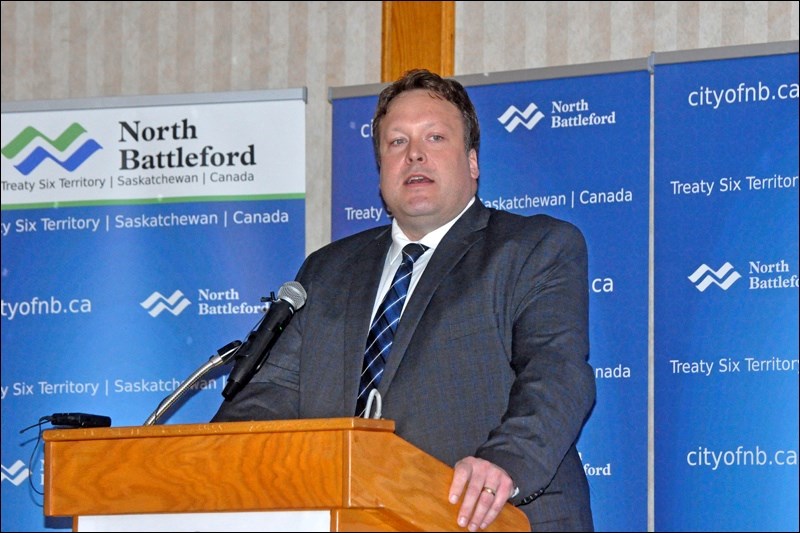Civic happenings were top of mind Monday at the Tropical Inn, where Mayor Ryan Bater gave his annual remarks in his State of the City event.
This was the first State of the City event that was hosted and organized by the city itself, in partnership with The Lighthouse Serving the Battlefords. Previously, municipal leaders had taken part in a Joint State of the City/State of the Town address organized by the Battlefords Chamber of Commerce, but the Chamber has opted to go ahead with a new event called the “Power Hour” later this week.
Whereas the previous chamber format provided a tight time frame for the mayors to speak, this new format allowed Bater more opportunity to speak at length on the issues faced by the city.
Bater’s speech lasted more than 45 minutes, and spanned the wide range of issues facing North Battleford. Topics Bater touched on were extensive and included Carlton Trail, the Red Pheasant Urban Reserve, the city’s recreational facilities and the Northland Power Curling Centre as well as the new metering regime.
Here is a sampling of some of Bater’s remarks during the noon-hour gathering.
Regional coalition:
Bater spoke about the Battlefords Regional Community Coalition – a coalition of local governments dedicating to addressing the issues in the region. He noted the signing of the Sacichawasihc Relationship Agreement involving the City of North Battleford, the Town of Battleford and five area First Nations. He also pointed to the recognition of those efforts with the Saskatchewan Municipal Award.
“Really this is about developing a good neighbour policy, and communicating” said Bater, “because the Battlefords is a regional community, and North Battleford is the hub of that region.”
Asset management:
Bater spoke about the new focus at City Hall on asset management efforts. He called it “one of the biggest transformations” at City Hall.
Bater defined asset management as “a snapshot of the city’s assets at a point in time, but it’s a valuation of those assets over the entire life cycle of the asset.” He noted it addressed operations and addressed risks and mitigation of risks.
“The most important thing and the most valuable discussion we are having as a council is it requires us to define levels of service so that we can answer that really important question that we get all the time as council members, ‘what am I getting for our taxes’?” said Bater.
“By defining levels of service within our assets, we’re having important conversations so that council understands the level of service, and so does administration.”
Bater also spoke about how asset management would be incorporated within the waste management facility in 2020, looking at things like hours it is open, and what happens with the facility during its useful life. The existing cell at the facility will need to be replaced by 2029, for instance, but Bater noted it could be three years sooner if the Saskatchewan Hospital is demolished and materials brought to the waste management facility.
“This is what asset management is about,” said Bater, who said it would take “three to five years” before all the city assets are covered.
Downtown:
Bater spoke about the ongoing efforts to revitalize the downtown core.
“We are now entering our fourth year of new construction for downtown,” said Bater, who said on the books for 2020 is continuation of work on 100th Street on the 1200 and 1300 blocks. This is to be a full rehabilitation with replacement of undergrounds and construction of roadways and sidewalks.
Bater continued to point to the growth of business downtown in the wake of those construction efforts. Since incorporating the downtown master plan and starting the rehabilitation, “we’ve attracted 17 new businesses downtown,” said Bater.
“The rejuvenation of downtown North Battleford is a success story that isn’t done being told yet. We’re going to have to continue making it a priority.”
Drugs and organized crime:
Crime was again a major topic, but this time Bater shifted gears by talking about the challenge the city and region faces in dealing with drug and gang issues.
“The situation here is methamphetamine,” said Bater. “A highly addictive, incredibly affordable drug that destroys people’s lives and families. We are really hoping there is a provincial response to this, but as the drug trade grows around western Canada and in regions like ours so does organized crime, and violence around it.”
The mayor noted from June to October last year there were 203 firearm related calls and 32 discharge of firearms reported out of Battlefords detachment of the RCMP.
Bater said the city worked with the Battlefords detachment to come up with a solution and that resulted in creation of the gang task force. They have put together a task force of four members of the RCMP out of rotation, and “their job is to make life uncomfortable for gangsters here. And they’re doing a very good job.”
In the first two months starting Nov. 1, there was a 50 per cent reduction in firearms and discharge calls, 44 warrants executed and 81 arrests, 47 provincial charges, 94 Criminal Code charges, and six ounces of crack and two loaded firearms taken off the streets.
Bater said they want to see this pilot program become permanent. The city has submitted a letter asking the RCMP for an additional member to go from 36 to 37 members, and Bater said they also want a five-year program for the gang task force for an additional four members there.
“We are hoping to work with our neighbouring municipal governments and the provincial government to come up with a way that we can all work together to fund that program.”




